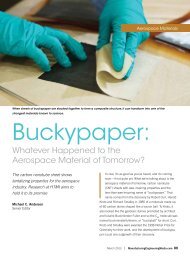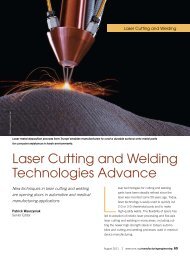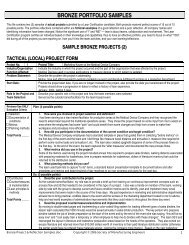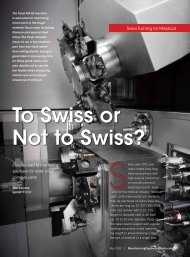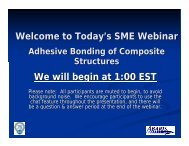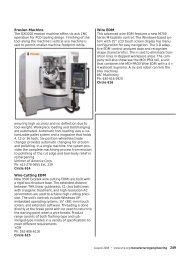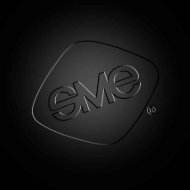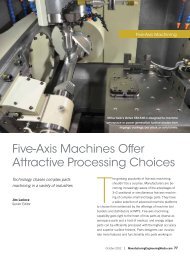The RAPID 2013 Conference & Exposition Directory - Society of ...
The RAPID 2013 Conference & Exposition Directory - Society of ...
The RAPID 2013 Conference & Exposition Directory - Society of ...
Create successful ePaper yourself
Turn your PDF publications into a flip-book with our unique Google optimized e-Paper software.
in the future <strong>of</strong> manufacturing, influencing product design to<br />
reduce costs while enhancing component functionality.<br />
2-2:25 pm<br />
Pulsed Photonic Curing <strong>of</strong><br />
Printed Functional Materials<br />
Denis Cormier, Earl W. Brinkman Pr<strong>of</strong>essor, Industrial<br />
and Systems Testing, Rochester Institute <strong>of</strong> Technology<br />
Stan Farnsworth, Vice President <strong>of</strong> Marketing, NovaCentrix<br />
<strong>The</strong> growing interest in hybrid processes that integrate<br />
electronics within additively manufactured parts can present<br />
significant challenges when the materials involved have<br />
significantly different melting/curing temperatures. Photonic<br />
curing has been used to rapidly heat printed inks and functional<br />
films to temperatures in excess <strong>of</strong> 1000°C on low-temperature<br />
substrates such as polymers and paper. It is therefore very well<br />
suited for use within hybrid multi-material AM processes. This<br />
presentation will begin with an overview <strong>of</strong> the process as well<br />
as a discussion <strong>of</strong> its strengths and limitations. <strong>The</strong> talk will<br />
then provide examples <strong>of</strong> high-temperature functional materials<br />
that have been printed on polymer AM part surfaces and then<br />
photonically cured. <strong>The</strong> talk will conclude with a discussion <strong>of</strong><br />
practical lessons learned.<br />
2:30–2:55 pm<br />
3D Structural Electronics Fabrication<br />
Using Fused Deposition Modeling<br />
and Direct-Write Micro-dispensing<br />
David Espalin, Graduate Research Associate, University <strong>of</strong> Texas<br />
at El Paso (W.M. Keck Center for 3D Innovation)<br />
Additive manufacturing fabricated unmanned aerial vehicles<br />
(UAVs) with integrated or printed electronics <strong>of</strong>fer 3D design<br />
and electronic packaging flexibility that may facilitate UAV<br />
multi-role performance (i.e., reconnaissance, combat, and<br />
logistics) and as such have received much attention in the AM<br />
community as <strong>of</strong> late. Fundamentally, the advancement <strong>of</strong> 3D<br />
structural electronics using AM partly hinges on effectively<br />
interconnecting electronic components. In this particular case,<br />
the dispensing <strong>of</strong> conductive inks on FDM produced surfaces<br />
presented several challenges including those related to wetting,<br />
electrical shorting between interconnections, and unintentional<br />
ink spreading throughout the part. As a solution to some <strong>of</strong> these<br />
issues, interconnection channels were used to confine or retain<br />
inks at the desired locations and prevent electrical shorting or<br />
ink spreading. Additionally, interconnection channels produced<br />
using micromachining achieved micro-scale features. Through<br />
this work, it was determined that FDM processing parameters<br />
and machining depths influenced successful electrical<br />
interconnection—which in the end, could be used to produce<br />
functional electronic systems using FDM.<br />
3–3:25 pm<br />
RF Printed Circuit Structures Using<br />
a Commercially Available Direct Print Tool<br />
Ken Church, PhD, President, nScrypt Inc.<br />
<strong>The</strong> mechanical segment <strong>of</strong> 3D printing has penetrated the<br />
manufacturing barrier, but the electrical segment has not.<br />
It is clear that mechanical structures are more mature than<br />
their electrical counter parts, but for the electrical segment to<br />
mature it must accomplish what the mechanical structures have<br />
accomplished; perform at a level that meets or exceeds state<strong>of</strong>-the-art.<br />
3D electronic structures that have unique shape but<br />
inferior performance will be novel but not pervasive. To address<br />
the electrical performance issue it is imperative to involve<br />
electrical experts in 3D printing. A number <strong>of</strong> companies and<br />
universities are working on 3D electronic devices and this will<br />
provide a foundation for future products, but more is needed to<br />
make this a viable solution for true printed circuits.<br />
nScrypt sells commercial tools for the electronic industry and<br />
has recently added an nScrypt Fused Deposition (nFD) pump on<br />
their micro-dispensing platform. 3D printing <strong>of</strong> next generation<br />
printed circuit structures has the potential to penetrate an<br />
existing printed circuit boards market; a commercially available<br />
3D printing tool can make this viable. nScrypt and the University<br />
<strong>of</strong> South Florida have teamed up to utilize this tool and work in<br />
the more challenging RF regime <strong>of</strong> printed electronics. Multi-bit<br />
RF phase shifters are challenging for any fabrication process<br />
and 3D printing these can show improvement in ruggedness<br />
and durability without degrading the performance. This has<br />
implications that reach into many industries, including the<br />
Department <strong>of</strong> Defense. In addition to the DoD, the printed<br />
circuit boards market for consumer products is in excess <strong>of</strong><br />
$50B annually. For these industries to embrace the 3D printing<br />
approach, the tools must be commercially available and<br />
6/<strong>2013</strong> – <strong>RAPID</strong> 53






